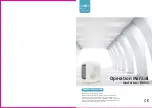
kaivac
cleaning
systems
TM
kaivac
cleaning
systems
TM
P a g e ǀ
1 2
1-800-287-1136
Customer/Technical Support
1.6 b
atteRy
i
nfoRMation
1.0 Getting Started
Keep Batteries at Room Temperature:
That means storing between 32 and 80 degrees F (00C to 270C). The worst thing that can happen to a lithi-
um-ion Battery is to have it exposed to elevated temperatures. Heat is by far the largest factor when it comes to reducing Battery life.
Batteries Lose Capacity Over Time:
Batteries naturally deteriorate over time whether being used or not. Batteries deteriorate at a rate of 10% run
time per year. You can expect to get 80 to 90 minutes of run time the first year and during the second year you will get approximately 71 to 81
minutes of run time.
Fully Discharge vs. Partial Discharge and the Effect on Battery Cycles:
Unlike lead acid batteries typically used in auto scrubber, the Kaivac Battery
is not damaged by fully discharging. The BMS (Battery Management System) has a cutoff voltage of 30V which protects the Battery from experi-
encing full discharge. Running the Battery to full discharge will reduce the amount of charge cycles. The expected hours of use are approximately
600 hours. For example, if running to full discharge, you would expect 400 cycles. If you run to 80% discharge, then you would expect to get more
cycles (500 cycles).
Extended Storage:
It is recommended to discharge to 40% capacity (35V) and store in a cool location (between 320
F to 80
0
F or 0
0C to 270C).
Hour
Meter:
The hour meter is like an odometer on a car. It only runs when the Battery is discharging or running the motor. Therefore, it displays the
number of hours that the Battery has run. Each 0.1 reading on the hour meter equates to 6 minutes of run time. A normal Battery should provide
540 to 600 hours of run time.
Battery Gauge:
The Kaivac Batteries come with a built-in Battery Gauge or “Fuel Gauge” which shows the approximate run time remaining.
Average Sq-Ft per Run Time:
40,000 - 55,000 sq.ft. depending on cleaning area.
Average Cleaning Rate:
20,000 sq.ft/gal.
Average Water Usage:
1,000 sq.ft/gal.
Disposal:
Properly dispose of Battery at a local recycling location.
Battery Box Specifications
Weight
16.8 lbs. (7,6 kg)
Body Material
Injection Mold Polypropylene
Dimensions (H x W x D)
13.5 x 19.5 x 10 in. (34,3 x 49,5 x 25,4 cm)
Voltage
36V DC
Battery Capacity
20 A-hr
Battery Current
15 A DC
Battery Type
Lithium-Ion
Approx. Run Time BOL (Beginning of Life)
75 to 85 minutes
Approx. Run Time EOL (End of Life)
50 minutes (discontinue use and take to recycling center)
Battery Box Receptacle
IP67 w/ cover (not required for UL)
Run Time Hour Meter
Acts as “odometer for battery” and runs only when motor switch is ON
Approx. Charge Cycles
400 @ 100% discharge / 500 @ 80% discharge
Cutof Voltage (fully discharged)
30V
Charger Specifications
Approx. Charge Time
5.5 hours
Charger Amps
5 Amps
Charge Voltage
42V DC
Charger Voltage
110-240VAC / 36VDC (240VAC version only needs correct plug for wall outlet)
Charging Robustness
No special instructions
Battery Charge Memory
None
Battery Charge Gauge
Yes, LED Indicator
Approx. Charge Cycles
400 @ 100% discharge / 500 @ 80% discharge
Storage/Inventory:
Storage & Operation Ambient Temp
32
0
F (0
0
C) to 80
0
F(27
0
C)
Storage & Shipping Charge
40-60% Charge (35-38VDC)
Summary of Contents for OmniFlex TROLLEY BUCKET
Page 2: ...kaivac cleaning systems TM...
Page 32: ......













































